Nin – the magical city of kings, sandy beaches and salt
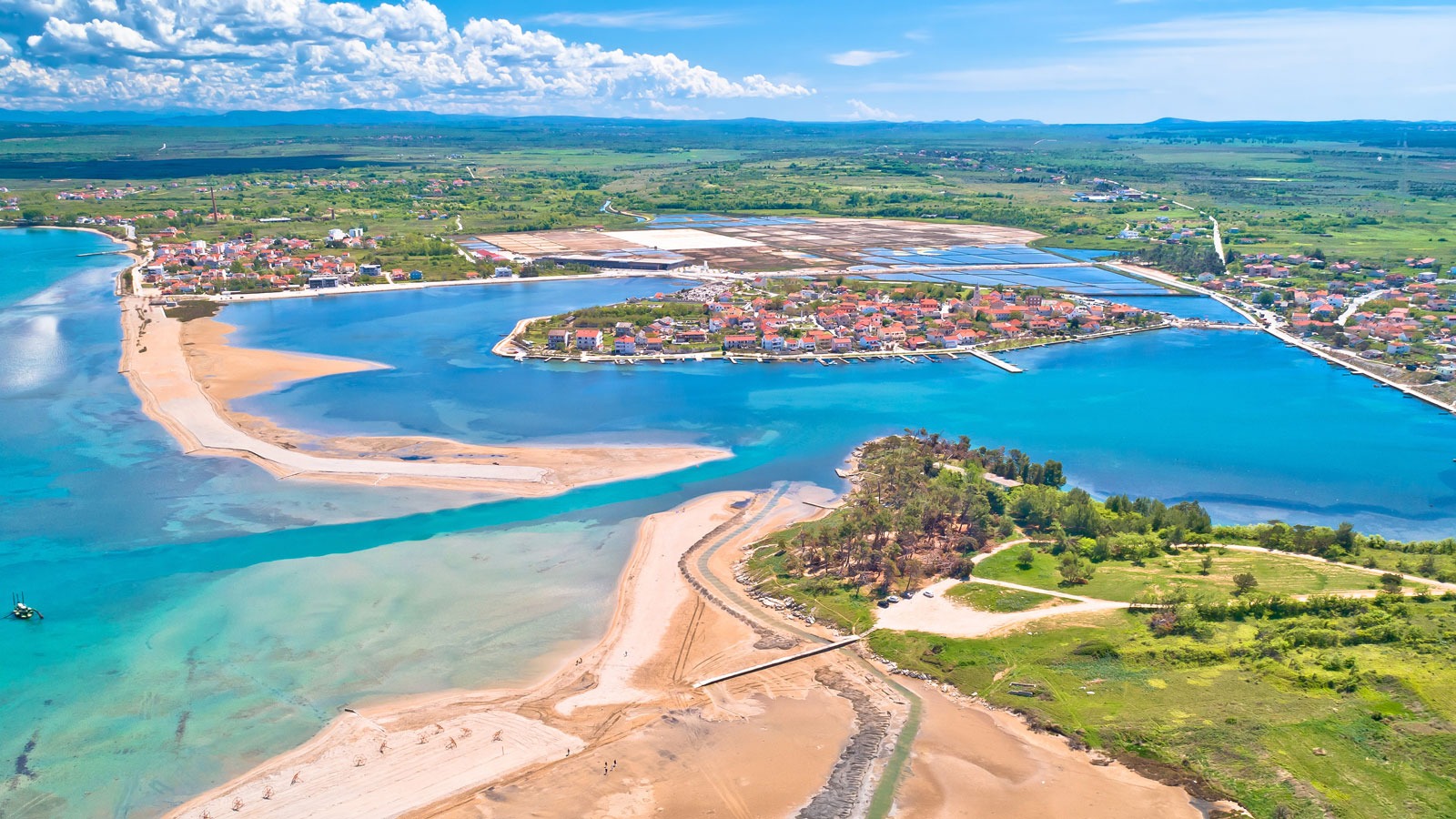
13
May 2024
Nin – the magical city of kings!
In 1996 two astronomers from the observatory in Višnjan, Istria, discovered an asteroid , which they named Aenona – the name of the oldest Croatian royal city of Nin.
As early as the 9th century. B.C. It was a strong center of shipping and trade and an important port on the eastern Adriatic coast, founded by the Illyrian tribe of Liburnes under the name of Aenona.
Nin is unearthly not only as a celestial body but also for its historical and natural values.
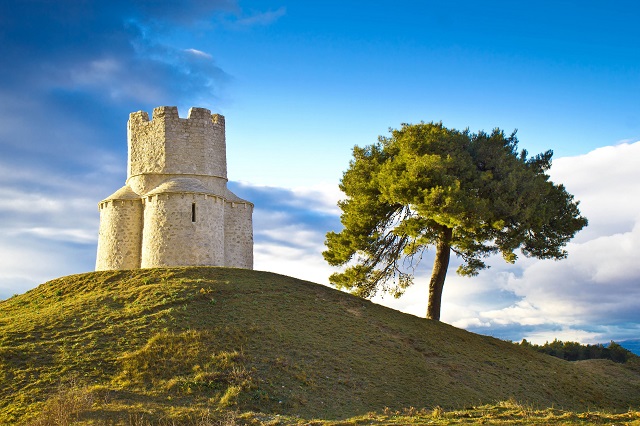
Nin symbol
Already arriving at the city, a gem of architecture appears to our eyes, its symbol foreshadowing the wonderful adventure with history that awaits us here literally at every turn. On a small hill in the middle of the vast Prahulje plain rises the early Romanesque church of St. Nicholas, dating from the turn of the 11th and 12th centuries. It resembles a mini-fortress, and indeed in the 16th-17th centuries, the time of the Turkish invasion, a defensive overhang was added and the structure served as a reconnaissance punt.
The temple is 5.9m long, 5.7m wide, 6m high and has walls 50 cm thick. Despite its inconspicuous size, it was an important coronation site for Croatian kings. It was here that each of the 7 rulers newly crowned in Nina presented themselves to the nation.
It is rumored that there are graves beneath the surface of the Prahulj hill that have not been explored to this day.
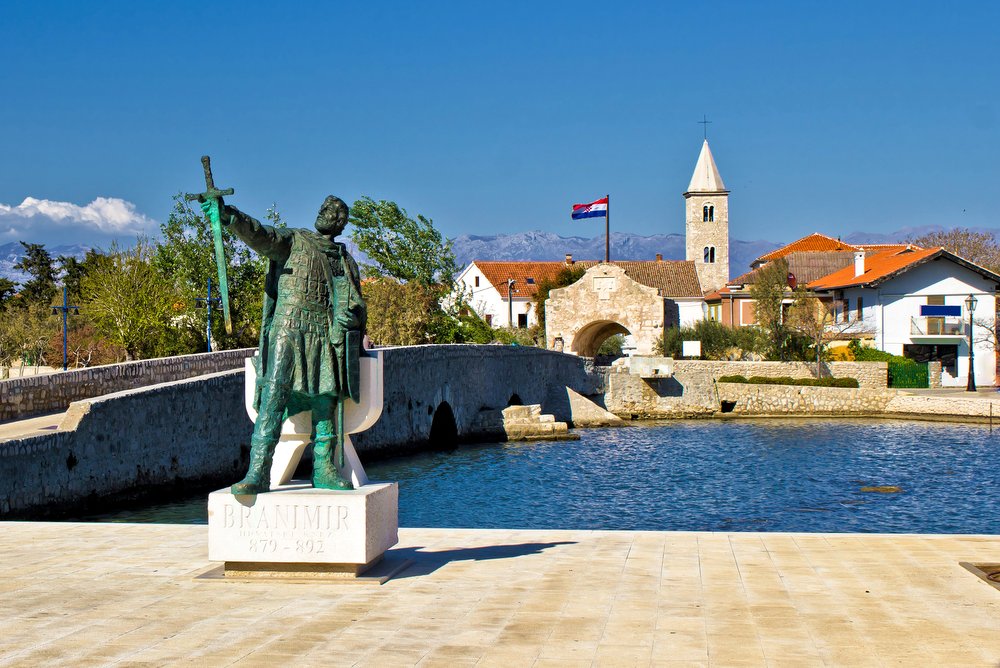
Old town
Today’s Ninsk Old Town is located on an island and can only be accessed by one of the stone bridges (dating back to the 16th century). The main entrance to the city is guarded by a statue of the gaggle Branimir. When you cross its ancient gates (16th-18th centuries) the magic of this place begins to work, history intertwines with the present
You drink coffee among the fragments of buildings from a thousand years ago, eat lunch by the walls of a Roman temple, rest in a meadow crisscrossed by the outlines of the walls of ancient houses, walk in the place where Croatian kings were crowned.
Daily life takes place in ancient, early Christian and medieval settings.
The best example is the remains of a Corinthian column in Višeslav Square, which today’s residents use as a pedestal for a statue of the Virgin Mary during an annual procession. Placed on it, blessed flowers are said to have miraculous powers.
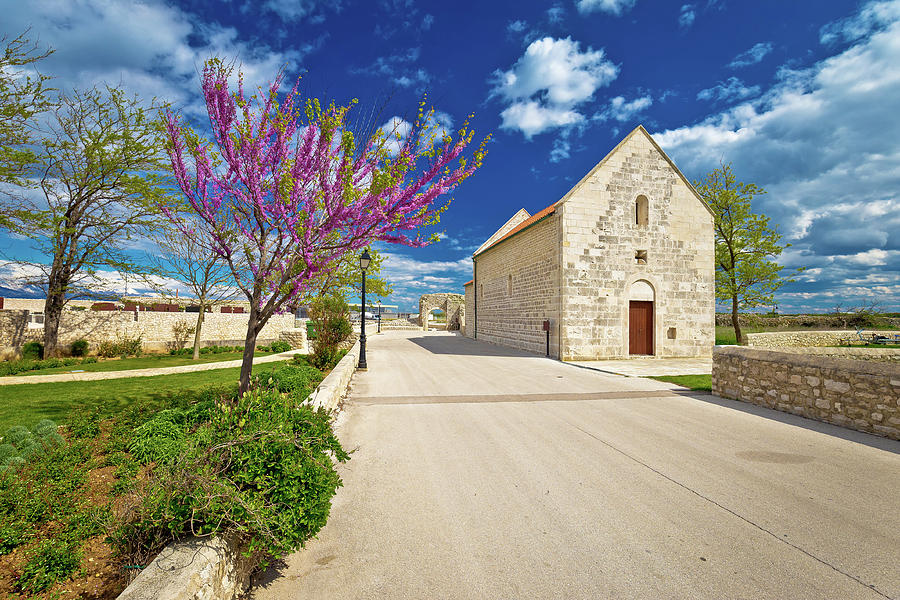
Nin is a city of churches, some of which no longer exist, but whose numerous valuable furnishings are preserved in the collection of ecclesiastical art Gold and silver of the city of Nin, displayed in rooms at the parish church of Saint Anselm. Among the most interesting are the ring of Pope Pius II from the 15th century. or Judas silver, one of 16 specimens recorded in Europe.
The parish church of St. St. Anselm’s Cathedral, called Nin Cathedral during the reign of the kings, dates back to the 6th century. The local chapel houses a statue of the venerated Nina Mother of God with a child (Gospa od Zečeva). Every year on May 5 and August 5, processions are held to nearby Zečevo, which is an island at high tide and connects to the mainland through a narrow passage at low tide.
The 13th century Church of St. Ambrose is worth a look and has been restored. with Romanesque-Gothic elements, picturesquely located near the Upper City Gate.
However, the undisputed historical gem is the pre-Romanesque St. Peter’s Church. The Cathedral of the Cross is commonly referred to as the world’s smallest cathedral. It is the most valuable surviving monument of Old Croatian religious architecture. It was built in the 9th century. on the ruins of ancient houses, the remains of which are visible around the structure. It is the only treasury site in Nina that has been preserved intact from its construction until today.
During the time of Croatian rulers, it served as a chapel at the nearby court, around which many medieval graves have been discovered.
Built on a cruciform plan, topped with a dome, it is 7.8m long, 7.6m wide, 8.2m high and the walls are 57cm thick.
The church, thanks to the position of the oval windows and the angle at which the light falls, is a kind of calendar and sundial showing the exact dates of the summer and winter solstices and equinoxes.Some compare it to Stonehenge.
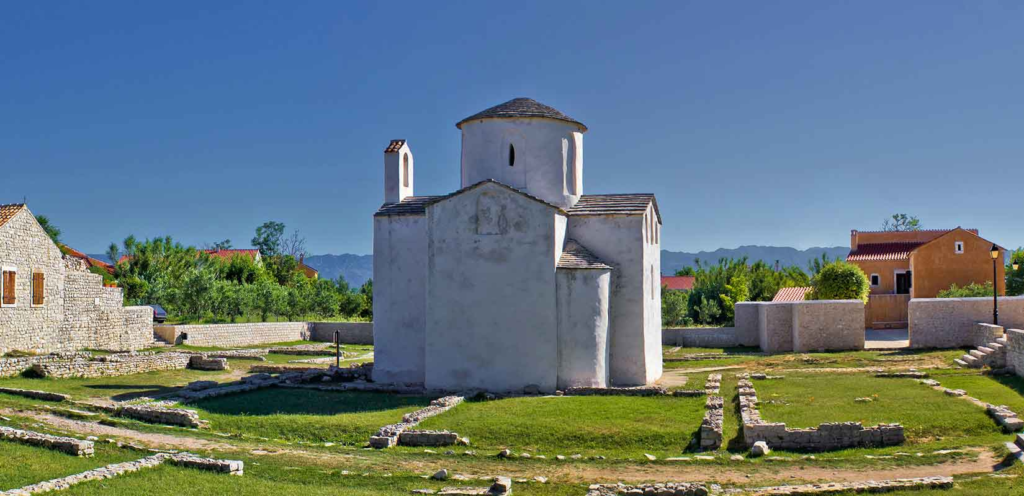
Roman ruins
In the pre-Christian era, other gods were worshipped in Nina. In the very center of the city, on the site of the former Roman forum are the remains of a monumental temple, the largest (33m x 23.5m ) on the eastern Adriatic coast. It dates to the second half of the first century AD, the time of Emperor Vespasian (69th – 79th AD). On the ruins of the temple we can see a Corinthian column in its original height of 17m. Meanwhile, in a part of the city called Banovac, the remains of a large Roman villa Urbane (17m x 30m ) were found. Rare floor mosaics from the 2nd century AD with geometric, animal and plant motifs have been preserved here.
Interestingly, northeast of Nin, in the village of Grbe, there is a stone structure that tourists take for a Roman triumphal arch. However, these are not ancient ruins but a monumental gateway to a former tobacco factory, on the remains of which today’s town has developed.
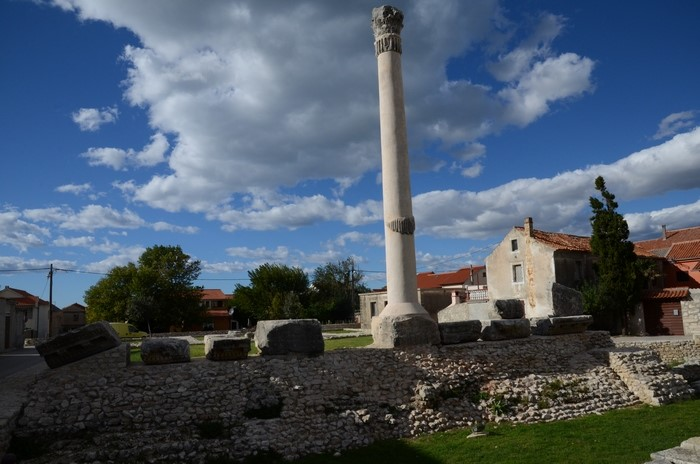
On the other hand, we can admire numerous artifacts from the prehistoric, Roman, Old Christian and Old Croatian periods at the Museum of Ninian Antiquities in Nina (it is a Division of the Archaeological Museum in Zdara).
The seven exhibition halls display items documenting the most important historical periods of the city’s development, reconstructions, mock-ups, photographs, and plans.
The most valuable of these are:
– Two original Old Croatian ships from the 11th century. Condura Croatica
– A replica of part of the first-century ship Serilia Liburnica.
– A copy of the baptismal font of Knez Višeslav (the first Croatian Knez, who reigned around 800 AD) – an excellent example of church furnishings from the time of the Christianization of the Croats. /The original is kept in the Museum of Croatian Archaeological Monuments in Split.
Condura Croatica
The history and story of Nin, the development of the city are inextricably linked to the long tradition of sailing. It is confirmed by the remains of Condura ships found at the entrance to Ninsky Harbor in 1966. After being excavated in 1974, the units were taken to Zadar where desalination, conservation and restoration began.
The remains of the ancient port itself (1st century BC) are located in the sea in today’s Zaton, in front of Cape Kremenjača, and are still being studied by underwater archaeologists.
The discovered ships sailed the seas from the end of the 11th century. and in the early 12th century. They are most likely the ones Emperor Constantine Porphyrogenet is referring to when he mentions the Old Croatian navy of 80 vessels. For this reason, they were given the name Condura Croatica.
It is interesting to note that these ships were the smallest and deadliest warships in world history. They were 7-8m long, narrow and built using the classic ribbed method with hull plating joined with wooden and iron nails. They had a sail. They were used as high-speed paddle ships.
Historical records state that during the reign of King Krešimir IV, Croatia had as many as 20,000 rowers on condors, with 15,000 rowers at King Tomislav’s disposal in Nina alone.
The town now has a population of 2,700 (according to the 2011 census), so you can imagine how big a metropolis it was in the Middle Ages.
The found Condura Croatica today is housed in a special museum pavilion in Nina, and its replica can be seen in the sea next to the Lower City Bridge.
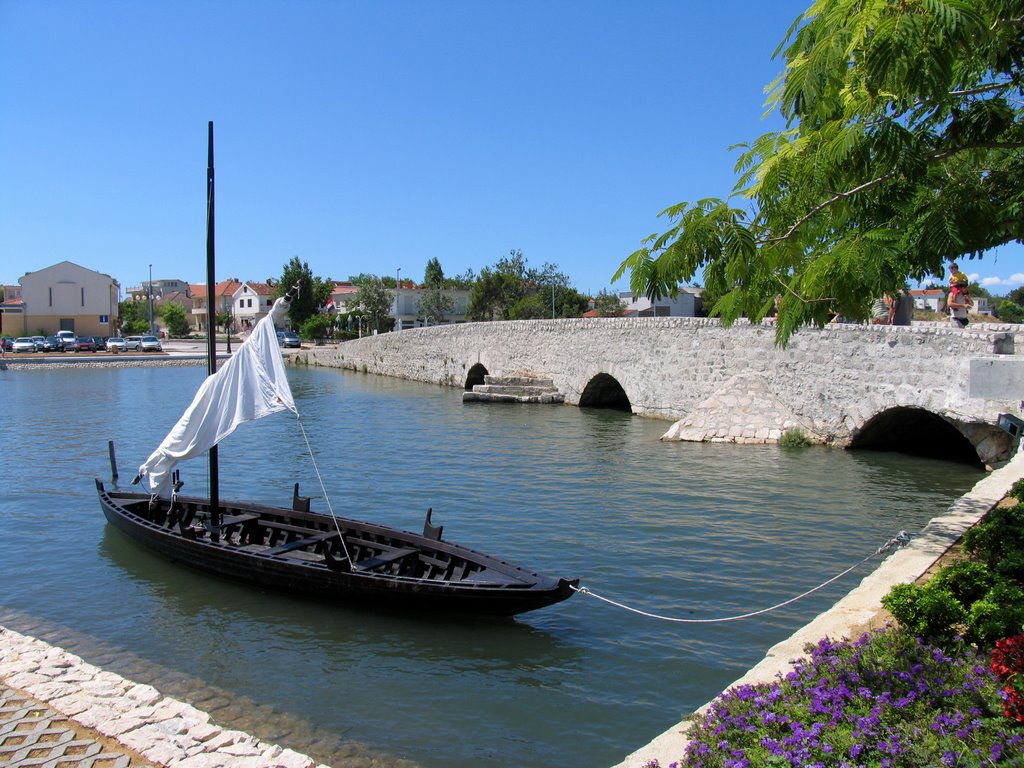
Salt more valuable than gold
The wealth and prosperity of the Nin region originated in the production of salt, which was at a premium in prehistoric and ancient times. The old method of production has been preserved to this day and we can discover its secrets at the Salt Museum. Ninian salinas take advantage of the natural strengths of the area: lots of days of sunshine, winds, geographic location. In shallow evaporation pools separated by dikes, seawater evaporates leaving mineral-rich salt at the bottom with a high iodine content (thanks to algae). It is harvested only by hand. This makes Nin salt one of the best quality in the world. Its most valuable type is the so-called salt flower – delicate, healthy and highly valued. It is formed only under certain conditions, when a thin layer of snowflake-like crystals forms on the water mirror. This salt caviar accounts for a small portion of production and fetches a much higher price.
This unusual rarity and other souvenirs such as various types of edible and bath salts, chocolates and salt cakes can be purchased at the Salt Museum.

